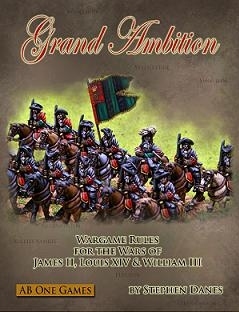
Grand Ambition
Grand Ambition is another set of rules that uses the AB One system. Having covered the Thirty Years War period and the English Civil War with previous versions, I wanted to finish off the seventeenth century by covering the wars of James II, Louis XIV and William III. This later period saw the rise of the standing army: regular troops, funded by the state and employed all year round. This period also saw significant developments in weaponry and tactics and it is these changes that I hope are reflected in the rules. Included in the Grand Ambition rule book are sections detailing with the organisation of troops and the type of formations and tactics deployed. All of the rules necessary to run the game including Initiative, Game Sequence and Movement, Shooting and Combat, Orders and Morale for individual units and the army as a whole, plus extensive army lists can be found here. In addition to this is the section describing the war-tokens and their usage plus a system regulating the deployment of armies and a system for generating battlefield terrain. Towards the rear of the rules can be found a section for converting the game to lower level "company actions" plus a method for generating scenarios for smaller scale engagements. Finally, the rules provide a scenario to use with the Grand Ambition rules which includes a map and order of battle for the game. And finally finally, not forgetting the war-tokens themselves which players can print-off and use in their Grand Ambition games.
– catalog listing
- Designer
- Stephen Danes
- Publisher
- AB One Games
- Status
- In Print
- Contents
- Available online (Wargame Vault) (63-page PDF)
Back to RULES DIRECTORY
Areas of InterestRenaissance
Featured Hobby News Article
Featured Link
Featured Ruleset
Featured Profile Article
Current Poll
|
Please sign in to your membership account, or, if you are not yet a member, please sign up for your free membership account.
Wargame Rules for the Wars of James II, Louis XIV & William III
|



